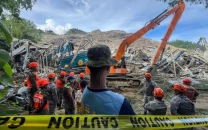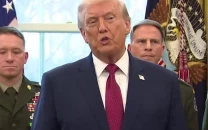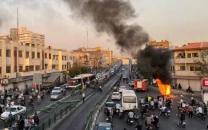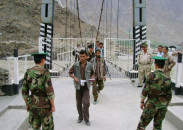Fighting capabilities affected by supporting state-owned aircraft maker: Indian air chief
Additional production of Su-30 is delayed by over two years and LCA production commitment by over six years, says HAL

PHOTO: AFP
Dhanoa remarked, “as a service; we have made concessions for HAL, but will the enemy make any concession for us when we face them in battle?”
The Indian air chief responded to criticism about the IAF’s alleged dislike for Light Combat Aircraft Tejas, the indigenous fighter made by HAL and in development for decades, during an international conference at the Centre for Air Power Studies (CAPS) in New Delhi.
“IAF has not shifted any goal posts as alleged,” Dhanoa said countering allegations that developments of the Tejas fighter suffered because the IAF changed specifications and requirements frequently.
Former French president laments fighter jet manufacturing deal with India
On the contrary, the air chief said, “We have maintained the Air Staff Quality Requirements (ASQR or specifications) of the first 20 LCA Mk-I at standards issued in 1985.” And even then HAL has been able to manufacture only 10 fighters," he added.
Following Dhanoa's statement, a spokesperson for HAL declined to provide any comments on the matter at a time when the Indian aircraft maker is in financial distress and embroiled in a controversy surrounding the Indian government’s Rafale fighter deal.
A HAL official who spoke on condition of anonymity asked: “Doesn’t IAF allow concessions and modifications to foreign vendors? Concessions are also given to Defence Research Development Organisation and the Aeronautical Development Agency. Why is HAL being singled out?”
The Indian air chief said that all work being done by the state-owned firm, was far behind schedule including the upgrading of one squadron of Jaguar deep strike bombers, nearly two squadrons of Su-30MKi, India’s mainstay fighters, and one squadron of Mirage-2000, a multi-role fighter.
He added, “Additional production of Su-30 is delayed by over two years and LCA production commitment (has been delayed) by over six years.”
Two Indian fighter pilots die in Mirage crash
He also revealed that IAF has lost as many as 17 personnel including test pilots and engineers in air accidents, in its quest for indigenisation. These accidents happened when “testing and evaluation” of the indigenous platforms such as Marut fighters and Kiran trainers.
The National Democratic Alliance’s deal to buy 36 Rafale fighters -replacing a deal by the previous government to buy 126 aircraft of which 108 were to be assembled in India by HAL - in a government to government deal from France has become controversial.
The opposition Congress and others have claimed the new deal costs more than the old one and that due process wasn’t followed, and that the new deal was done to benefit Reliance Defence, an offset partner of Rafale maker Dassault, however Reliance, Dassault and the Indian government have denied this claim and have said the old deal wasn’t viable.
The government has also said the prices are not comparable because the new deal also includes India-specific customisation and weapons.
Indian politician accuses French CEO of 'hiding truth' in Rafale deal
The Indian Supreme Court recently said it believes due process was followed in the deal and that it wouldn’t go into the pricing of the deal, effectively giving the government a clean chit.
In the thick of the controversy, HAL’s ability to manufacture aircraft has also been called into question.
The IAF chief also said that the force can’t cut down either expenditure or its workforce anymore. “The entire salary bill of the IAF is Rs16,621 crores, while our capital expenditure is Rs35,407 crores. We need Rs8,870 crores for fuel and maintenance.” He added: “There is no way we can cut our manpower to pay for our capital acquisitions.”
Explaining the high cost of operations, the IAF chief explained: “Manning of a Su-30 squadron is nearly twice that of a MiG-21 squadron and the cost of per hour operation is 3.5 times higher.”
This story was originally published by HindustanTimes.



















COMMENTS
Comments are moderated and generally will be posted if they are on-topic and not abusive.
For more information, please see our Comments FAQ